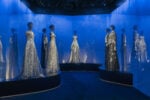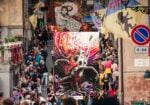Amir Yatziv – Everything was new abandoned and destroyed
.jpg)
L’artista israeliano torna ad occuparsi di un tema a lui molto caro come l’architettura in relazione con i conflitti che hanno segnato il secolo passato e la sua storia. Le immagini in mostra provengono da una serie di vecchi castelli in rovina sparsi tra Israele e Palestina e risalenti al periodo delle crociate.
Comunicato stampa
Laveronica arte contemporanea is pleased to present Amir Yatziv’s second solo show staged at the gallery, featuring a series of photos and a video from his recent project, Crusaders.
The Israeli artist has returned to a subject about which he cares deeply: architecture in relation to the conflicts that marked the last century and its history. The images on display show a series of old and ruined castles in Israel and Palestine, dating to the period of the Crusades. The ruins bear silent witness to ancient and contemporary catastrophes, but also to the underground struggles involving the continuous rewriting of history. Consecrated by the Jews and the Arabs in the same way, the ruins have become icons of a national tragedy and the metaphor for exile and redemption. What controls them is memory.
More than anywhere else, in these places the past is not a separate world. Everything connected with archaeology is immediately used as an instrument aimed at current and future conflicts. The period of the Crusades is an example. While the Palestinians tried to prove that the Zionists were foreigners and transitory, just as their Christian predecessors had been, the Zionists – often erroneously – attributed the colossal ruins to the knights of the past in order to belittle the native population’s contribution to the country’s history, culture and conformation. After the Crusaders left this land, the local population modified their structures according to need, enlarging some of them and destroying others. According to many Israeli archaeologists, the Palestinian settlements that preceded the Crusades cannot be studied without considering them to be from the era of the Crusades, but this is often wrong. Many noble residences in Palestinian villages have been defined “Crusaders’ Fortresses”, simply because their new owners were unable to believe that the Arabs could have built such beautiful homes.
During the project, Yatziv visited 17 sites that the archaeologist Dr Raz Kletter describes as “a Garden of Eden where everything was new, abandoned and destroyed, and in which the two eternal pillars of archaeology – creation and destruction – reigned supreme”. The artist also relied on documents found in 1948 in the Israel State Archives, and he met archaeologists and historians, including Kletter and Noga Kadman.
The video and prints were made using a 3D scanner, the same technology architects use for the conservation of ruins.
Amir Yatziv lives and works in Tel-Aviv and Berlin.
Solo exhibition: This is Jerusalem Mr. Pasolini, Petah Tikva Museum of Art, Israel (2013), This is Jerusalem Mr. Pasolini, Galleria Laveronica, Modica, Italy (2012), Antipodes, Ramat-Gan Museum of Art, Tel-Aviv (2010), Arbeit Macht Frei, Appendix2 Gallery, Warsaw (2010). Group exhibitions (selected): Too early, too late. Middle east and modernity, curated by Marco Scotini, Pinacoteca Nazionale, Bologna (2015), Space Oddity, A capsule exhibition, Kunsteverein Nürnberg, Germany (2014), La guerra che verrà non è la prima, 1914 – 2014, MaRT, Rovereto (2014), Recalculating Route, 4 Mediations Biennale, Poznan (2014), CounterIntelligence, Hart House, curated by Charles Stankievech, University of Toronto, Canada (2014), Time Pieces, Nordstern Videokunstzentrum, curated by Marius Babias and Kathrin Becker, Gelsenkirchen, Germany (2014), Measure for Measure, curated by Drorit gur-arie and Hila Cohen-Schneiderman, Petah Tikva Museum of Art, Israel (2014), Give Us The Future, curated by Frank Wagner, n.b.k Berlin, Germany (2014), Artists' Film International, Whitechapel Gallery, London, United Kingdom (2014), Multiplicity, NURTUREart, curated by Marco Antonini and Hila Cohen-Schneiderman, NY, USA (2014), The Israeli Video and Art Experimental Film Competition, Jerusalem Film Festival, Israel (2013), Scenographies, Stedelijk Museum Bureau in Amsterdam, Netherlands (2013), Rising star, Herzliya Museum of Contemporary Art, Israel (2013), Panorama – Junge Videokunst aus Israel, WESERBURG | Museum für moderne Kunst, Bremen, Germany (2013), Fresh Paint 6, Tel-Aviv, Israel (2013), I Vespri, civic forum in five acts, Modica, Italy (2012), Synthetic Rituals, Prichard Gallery, University of Idaho, USA (2012), Fresh Paint 5, Tel-Aviv, Israel (2012), Deviants, The Israeli Centre for Digital Art, Holon, Israel (2012), Artissima 18, Torino, Italy (2011).
Amir Yatziv
Everything was new, abandoned and destroyed
Inaugurazione Sabato, 4 Aprile 2015, ore 18.30
07.04.15 – 30.06.15
Laveronica arte contemporanea è lieta di presentare la seconda mostra personale di Amir Yatziv negli spazi della galleria. In mostra una serie di foto e un video provenienti dal recente progetto Crusaders.
L’artista israeliano torna ad occuparsi di un tema a lui molto caro come l’architettura in relazione con i conflitti che hanno segnato il secolo passato e la sua storia. Le immagini in mostra provengono da una serie di vecchi castelli in rovina sparsi tra Israele e Palestina e risalenti al periodo delle crociate. Le rovine testimoniano silenziosamente le catastrofi antiche e contemporanee, ma anche le lotte sotterranee che riguardano il riscrivere continuo della storia. Consacrate dagli Ebrei e dagli Arabi allo stesso modo, le rovine sono diventate icone di una tragedia nazionale e metafora dell’esilio e della redenzione. Ciò che le governa è la memoria.
Più che in qualsiasi altro luogo, in quei luoghi il passato non è un mondo a sé stante. Tutto ciò che è collegato all’archeologia è immediatamente usato come strumento finalizzato ai conflitti attuali e a quelli futuri. Il periodo delle Crociate ne è l’esempio: mentre i Palestinesi cercavano di provare che i Sionisti erano stranieri e passeggeri così come lo sono stati i loro predecessori Cristiani, i Sionisti attribuivano le colossali rovine, spesso erroneamente, ai cavalieri dei tempi passati per sminuire il contributo della popolazione indigena alla storia, alla cultura e alla conformazione del paese. Dopo che i Crociati hanno lasciato il paese, la popolazione locale ha modificato le loro strutture a seconda delle sue necessità, ingrandendone qualcuna e distruggendone qualche altra. Secondo molti archeologi Israeliani, gli insediamenti Palestinesi che hanno preceduto le Crociate non possono essere studiate se non considerandole dell’epoca delle Crociate, spesso però erroneamente: molte residenze signorili nei villaggi Palestinesi sono state definite “Fortezze dei Crociati”, semplicemente poiché i loro nuovi padroni non riuscivano a credere che gli Arabi potessero costruire delle case così belle.
Durante la realizzazione del progetto, Amir Yatziv ha visitato 17 siti che l’archeologo Dr. Raz Kletter descrive come “un Giardino dell’Eden dove tutto era nuovo, abbandonato, e distrutto e nel quale i due eterni pilastri dell’archeologia – creazione e distruzione – regnavano supremi." L’artista si è anche basato su documenti trovati nel 1948 nell’Archivio di Stato Israeliano ed ha incontrato archeologi e storici tra cui lo stesso Kletter e Noga Kadman. Il video e le stampe sono state fatte utilizzando la tecnologia dello scanner 3D – la stessa tecnica che gli architetti utilizzano per la conservazione delle rovine.
Amir Yatziv vive e lavora tra Tel-Aviv e Berlino.
Mostre personali: This is Jerusalem Mr. Pasolini, Petah Tikva Museum of Art, Israele (2013), This is Jerusalem Mr. Pasolini, Galleria Laveronica, Modica, Italia (2012), Antipodes, Ramat-Gan Museum of Art, Tel-Aviv (2010), Arbeit Macht Frei, Appendix2 Gallery, Varsavia (2010). Mostre collettive (selezionate): Too early, too late. Middle east and modernity, curata da Marco Scotini, Pinacoteca Nazionale, Bologna (2015), Space Oddity, A capsule exhibition, Kunsteverein Nürnberg, Germania (2014), La guerra che verrà non è la prima, 1914 – 2014, MaRT, Rovereto (2014), Recalculating Route, 4 Mediations Biennale, Poznan (2014), CounterIntelligence, Hart House, curata da Charles Stankievech, University of Toronto, Canada (2014), Time Pieces, Nordstern Videokunstzentrum, curata da Marius Babias and Kathrin Becker, Gelsenkirchen, Germania (2014), Measure for Measure, curata da Drorit gur-arie e Hila Cohen-Schneiderman, Petah Tikva Museum of Art, Israele (2014), Give Us The Future, curata da Frank Wagner, n.b.k Berlin, Germania (2014), Artists' Film International, Whitechapel Gallery, Londra, Inghilterra (2014), Multiplicity, NURTUREart, curata da Marco Antonini e Hila Cohen-Schneiderman, NY, USA (2014), The Israeli Video and Art Experimental Film Competition, Jerusalem Film Festival, Israele (2013), Scenographies, Stedelijk Museum Bureau in Amsterdam, Netherlands (2013), Rising star, Herzliya Museum of Contemporary Art, Israele (2013), Panorama – Junge Videokunst aus Israel, WESERBURG | Museum für moderne Kunst, Bremen, Germania (2013), Fresh Paint 6, Tel-Aviv, Israele (2013), I Vespri, civic forum in five acts, Modica, Italia (2012), Synthetic Rituals, Prichard Gallery, University of Idaho, USA (2012), Fresh Paint 5, Tel-Aviv, Israele (2012), Deviants, The Israeli Centre for Digital Art, Holon, Israele (2012), Artissima 18, Torino, Italia (2011).



